Did you know that by 2027, online sales will account for a staggering 25% of global retail sales?
The explosive growth of e-commerce is no surprise—fueled by the post-COVID digital surge, widespread internet access, and the irresistible convenience of online shopping.
Today’s consumers love the freedom to shop anytime, anywhere, without battling crowded aisles or waiting in long checkout lines.
At Global Media Insight, we have seen this shift firsthand.
Over the past five years, inquiries about e-commerce website development have surged by 15%, reflecting the growing demand for strong digital storefronts.
Thinking of launching your own online business?
You’re in the right place. In this guide, we’ll walk you through everything you need to know to build an e-commerce website—from defining your goals to choosing the right e-commerce platform and implementing smart e-commerce solutions.
But first, let’s start with the basics.
What is Ecommerce Website Development?
Ecommerce website development refers to the process of creating an online platform that enables a business to sell its products or services.
This development typically involves three main options:
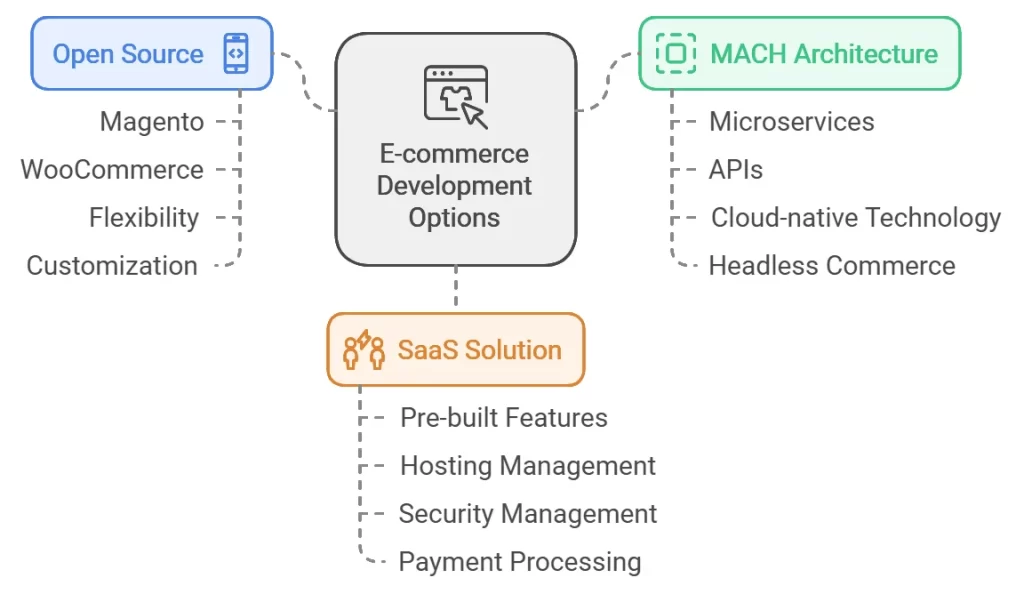
1. Open-Source Platforms: Power and Customization
If your business has access to an in-house development team or partners with an experienced web development agency, open-source platforms like Magento or WooCommerce offer powerful control and deep customization capabilities. These platforms give you complete ownership of your website’s code, allowing you to build tailored experiences that suit unique operational workflows.
For instance, companies in industries like wholesale or manufacturing often need features such as customer-specific pricing, multi-warehouse inventory sync, or complex tax rules — all of which can be custom-built on open-source platforms. The flexibility also extends to integrating third-party tools and fine-tuning performance for specific use cases, like region-specific storefronts or multilingual support.
However, managing an open-source platform requires ongoing technical maintenance — including handling security patches, software updates, and server performance — making it a better fit for businesses with technical expertise or the budget to outsource.
2. MACH Architecture: Scalable and Future-Proof
For businesses aiming to scale rapidly and innovate continuously, MACH architecture is an ideal choice. It stands for Microservices, API-first, Cloud-native, and Headless — a modular approach that separates the front end from the back end, making your ecommerce system more adaptable and agile.
What sets MACH apart is its composable structure. You can select best-of-breed services — such as one vendor for your CMS, another for search, and a different one for checkout — and connect them via APIs. This allows you to upgrade or swap components without disrupting the entire system, which is especially valuable for businesses with evolving needs or those entering new markets.
Retailers and enterprises use MACH to deliver personalized, fast-loading, mobile-first experiences across multiple digital touchpoints. For example, a fashion brand might run personalized campaigns based on customer behavior and manage them independently from the core ecommerce platform, improving both agility and conversion rates.
3. SaaS Solutions: Simplicity with Speed
For small to mid-sized businesses, or anyone looking to launch quickly and without heavy technical involvement, SaaS platforms like Shopify, BigCommerce, or Wix Ecommerce offer a fast and efficient route to market. These platforms handle the heavy lifting — such as hosting, security, PCI compliance, and performance optimization — so you can focus on running your business.
While often seen as beginner-friendly, today’s SaaS platforms are built to scale. Shopify, for example, supports integrations with enterprise-level systems and enables headless setups for greater design flexibility. You can launch with a pre-built template and evolve into a fully branded experience with custom apps, advanced marketing tools, and multi-channel selling.
During high-traffic periods like Black Friday, SaaS providers automatically scale resources to prevent downtime or slow loading — a crucial advantage for fast-growing ecommerce brands.
An Eleven Step Process to Ecommerce Website Development
Creating a successful online store needs careful planning and a bit of ongoing work.
We’re here to help you with each step along the way.
From setting up your website to promoting it and making improvements, these eleven steps will show you how to create an online store that attracts customers and boosts sales.
With a clear plan and smart digital marketing strategies, you can build an ecommerce website that helps your business grow.
To give you a quick overview, here’s a table outlining the key steps to e-commerce web development:
Steps | Action | Description |
1 | Define Your Goals and Know Your Audience | Identify products, understand target customers, and set clear business goals. |
2 | Choose the Right eCommerce CMS Platform | Explore CMS options, evaluate based on needs, and select the best platform for your business. |
3 | Select a Domain Name and Reliable Hosting | Choose a memorable domain name, secure reliable hosting, and register with trusted providers. |
4 | Focus on E-commerce Web Design | Create a user-friendly layout, optimize for mobile, add detailed product info, and ensure secure checkout. |
5 | Stock Your Online Store with Products | Organize products into categories, provide detailed descriptions, and add high-quality images. |
6 | Set Up Payment and Shipping Options | Choose a secure payment gateway, configure shipping rates, and define delivery areas. |
7 | Create Other Essential Pages | Add About Us, Contact Us, Shipping Info, Return Policy, Terms & Conditions, Privacy Policy, FAQ, and Blog pages. |
8 | Optimize Your Website for Search Engines | Use relevant keywords, optimize content, improve meta tags, and create clean, SEO-friendly URLs. |
9 | Test Your Website and Prepare for Launch | Test functionality, fix broken links, check loading speed, and ensure cross-device compatibility. |
10 | Promote Your Store and Keep It Growing | Leverage social media, email marketing, content creation, paid ads, and continuous SEO efforts to attract and retain customers. |
11 | Monitor Performance and Optimize | Use analytics tools, track key metrics, identify improvement areas, and adjust strategies to enhance performance. |
Ready to dive in?
Let’s break down each step:
Step 1: Define Your Goals and Know Your Audience
Before diving into building your ecommerce website, start by clarifying your goals and understanding who you’re selling to.
Here’s how:
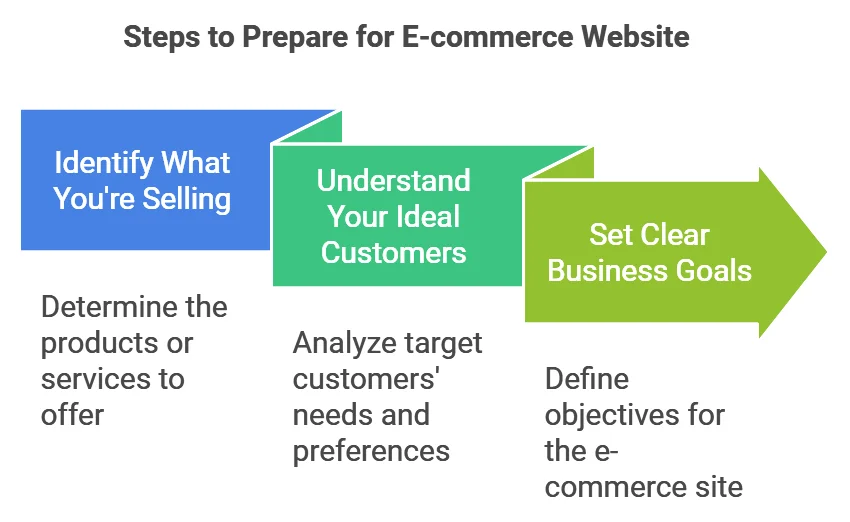
Identify What You’re Selling: Determine the products or services you want to offer. Knowing your inventory will guide the design and functionality of your website.
Understand Your Ideal Customers: Figure out who your target customers are. What are their needs, preferences, and shopping habits? This insight helps you create a website that appeals directly to them.
Set Clear Business Goals: Decide what you want to achieve with your e-commerce site. Are you looking to increase sales, enhance your brand’s visibility, or both? Your goals will shape your website’s features and marketing strategies.
Step 2: Choose the Right eCommerce CMS Platform
With your goals and audience in mind, it’s time to select an ecommerce CMS (Content Management System) platform that fits your needs.
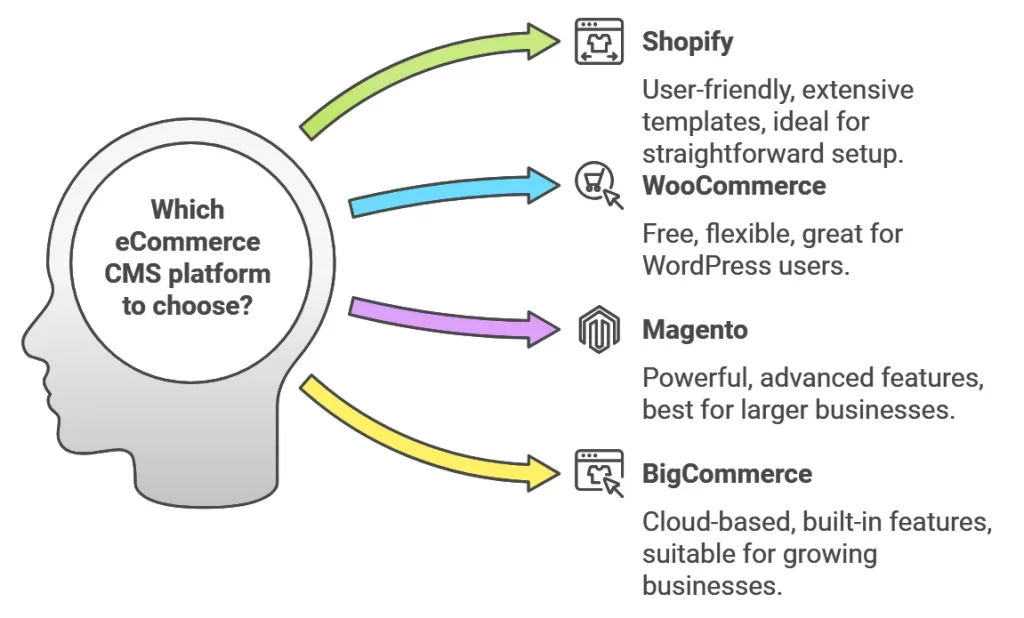
Here’s how to choose the right one:
1. Explore Your Options
There are several ecommerce CMS platforms available, each with unique features:
Shopify: Known for its user-friendly interface, extensive templates, and apps. Ideal if you want a straightforward setup and ongoing support. Learn more about setting up a Shopify store in the UAE.
WooCommerce: A free plugin for WordPress that offers flexibility and customization. Great for those familiar with WordPress and looking for a cost-effective solution.
Magento: A powerful option for larger businesses needing advanced features and scalability. Best for those who require a robust, customizable platform.
BigCommerce: A cloud-based platform with built-in features and scalability. Suitable for growing businesses looking for a comprehensive solution.
2. Consider Your Needs
Evaluate each platform based on your budget, technical skills, and business requirements.
Think about factors like ease of use, customization options, and whether the platform can grow with your business.
3. Make an Informed Choice
The right ecommerce CMS platform will support your business goals and ensure your store operates smoothly.
Choosing wisely helps you create a successful online shopping experience and supports your long-term growth.
Step 3: Select a Domain Name and Reliable Hosting
Once you’ve chosen your e-commerce platform, it’s time to focus on setting up your online store’s essentials: your website domain name and hosting.
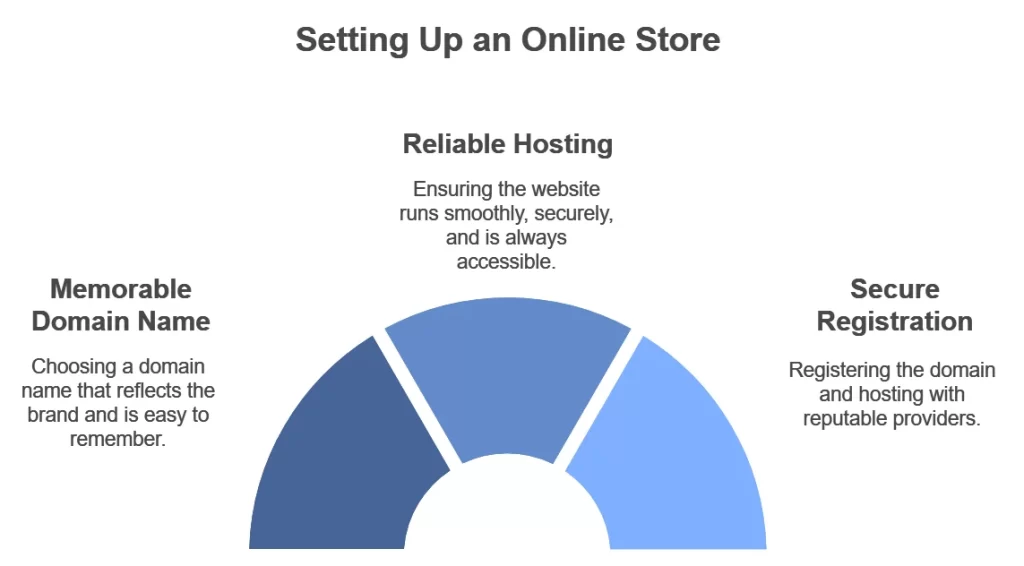
Here’s how to do it:
Pick a Memorable Domain Name: Your domain name is your store’s online address—like a memorable name for a new shop. Choose a name that reflects your brand and is easy to remember. If you’re moving your existing business online, you can use your current shop’s name to maintain brand consistency.
Choose Reliable Website Hosting: Hosting is like the parking space for your online store. A good website hosting service ensures that your website runs smoothly, stays secure, and is always accessible to customers. Look for a website hosting provider that offers reliability, speed, and excellent customer support.
Secure Your Domain and Hosting: Register your chosen domain name and set up your hosting service. Ensure that both are from reputable providers to avoid future issues and to provide a seamless shopping experience for your customers.
Step 4: Focus on E-commerce Web Design
The design of your e-commerce website plays a crucial role in attracting and keeping customers.
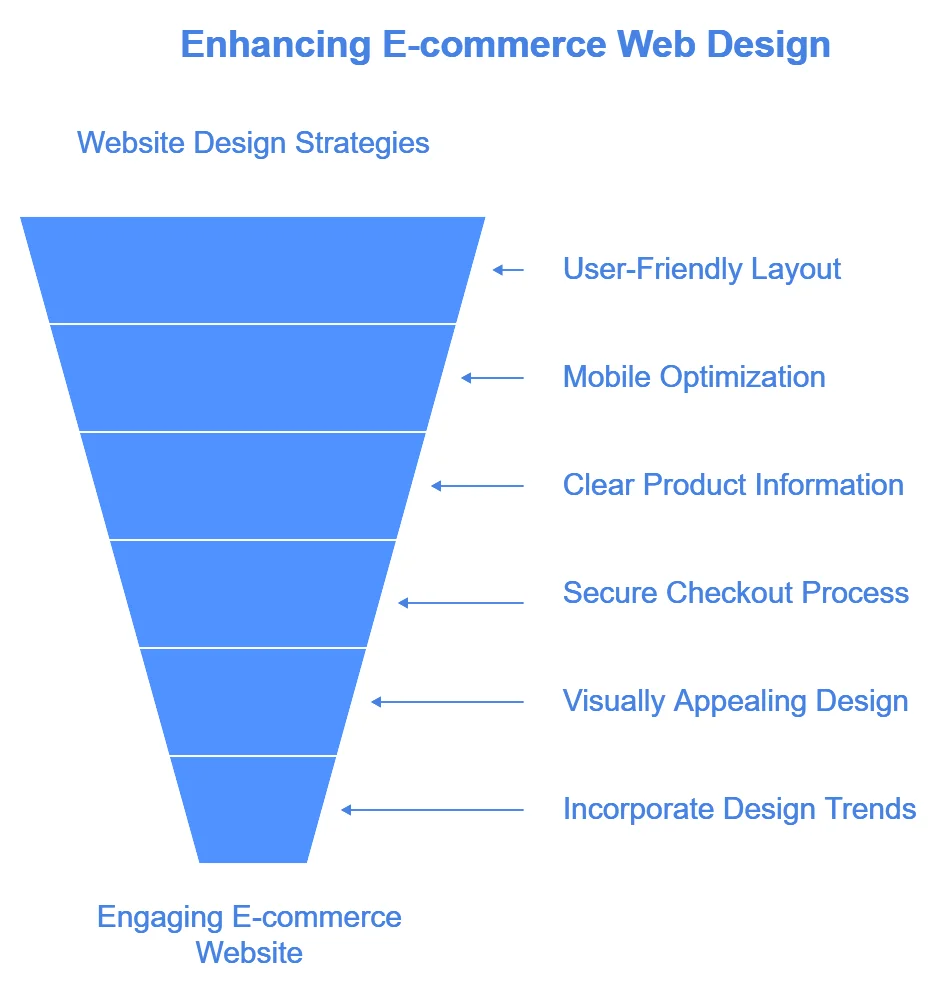
Here’s how to get it right:
Create a User-Friendly Layout: Design your website so that it’s easy for visitors to navigate. Make sure they can quickly find what they’re looking for without any confusion. A well-organized layout enhances the shopping experience.
Optimize for Mobile Devices: Ensure that your website looks great and functions smoothly on all types of devices, including smartphones and tablets. A mobile-friendly design is essential, as many customers shop on the go.
Provide Clear Product Information: Include detailed descriptions, high-quality images, and customer reviews for your products. This helps shoppers make informed decisions and builds trust in your store.
Ensure a Secure Checkout Process: Use a reliable and secure payment gateway to protect your customers’ payment information. A safe checkout process is crucial for building customer confidence.
Adopt Visually Appealing Design: Maintain consistent branding and choose a design that is both attractive and professional. The look and feel of your website should align with your brand and appeal to your target audience.
Incorporate E-commerce Web Design Trends: Stay updated with the latest ecommerce design trends to make your website modern and engaging. Using current design trends can help you create a fresh and appealing online store that captures customer interest and encourages repeat visits.
Step 5: Stock Your Online Store with Products
Once your website design is ready, it’s time to fill your store with products.
Think of this like setting up a physical shop where you carefully arrange items on shelves to make them look appealing and easy to find.

Here’s how to get it right:
Organize Products: Group similar products together into categories. This makes it easier for customers to find what they’re looking for. Categories can be based on product type, price range, new arrivals, etc.
Provide Detailed Information: On each product page, include all the key details about the product. For example, if you’re selling shoes, clearly mention if they’re sports shoes, formal shoes, or casual shoes. Specify if they’re for men, women, kids, boys, or girls, along with other important details like size, price, and more. In the product description, talk about how the shoes feel, how they look, when they’re best worn, and any unique features. Adding relevant keywords will also help customers find your product more easily online.
Step 6: Set Up Payment and Shipping Options
To complete your e-commerce website, you need to set up payment and shipping options.
This is like setting up a checkout counter and organizing how your products will reach your customers.
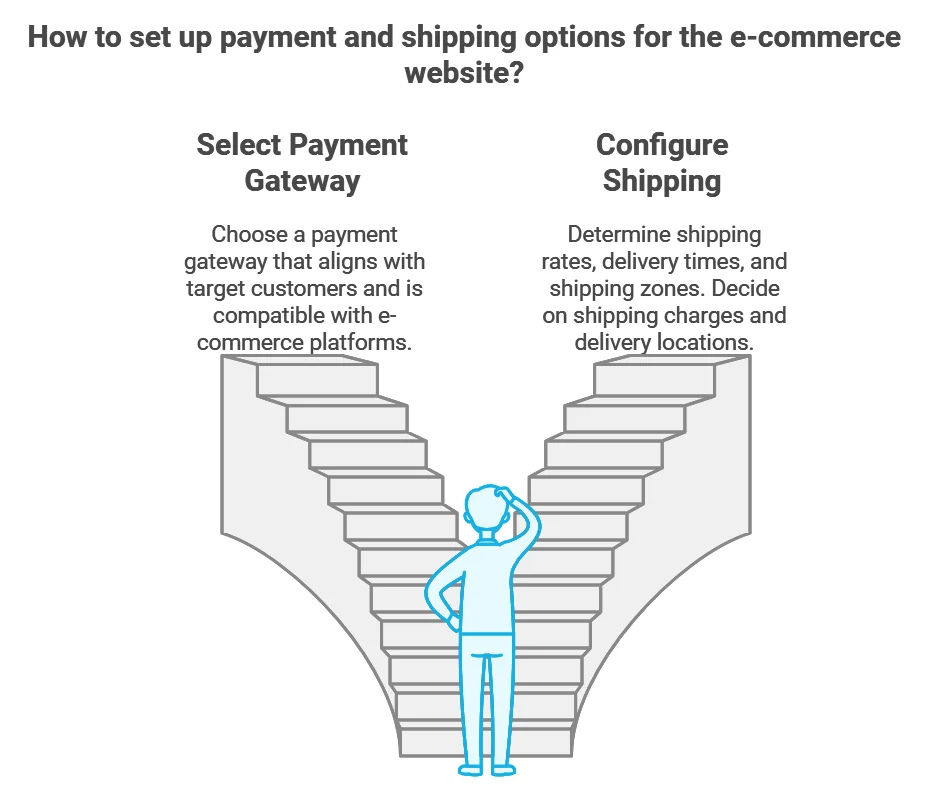
Here’s what you need to do:
Selecting the payment gateway: A payment gateway should consider factors like customer preferences, geographical location, etc. You should choose a gateway that aligns with the target customers and is compatible with e-commerce platforms.
Configure Shipping: Once you select the gateway, determine your shipping rates, delivery times, and shipping zones. Decide how much you’ll charge for shipping and where you’ll deliver.
Step 7: Create Other Essential Pages for Your E-Commerce Store
To ensure your e-commerce store builds trust with customers, you need to include several key pages other than product pages.
These pages help provide important information, make your store more user-friendly, and meet legal requirements.
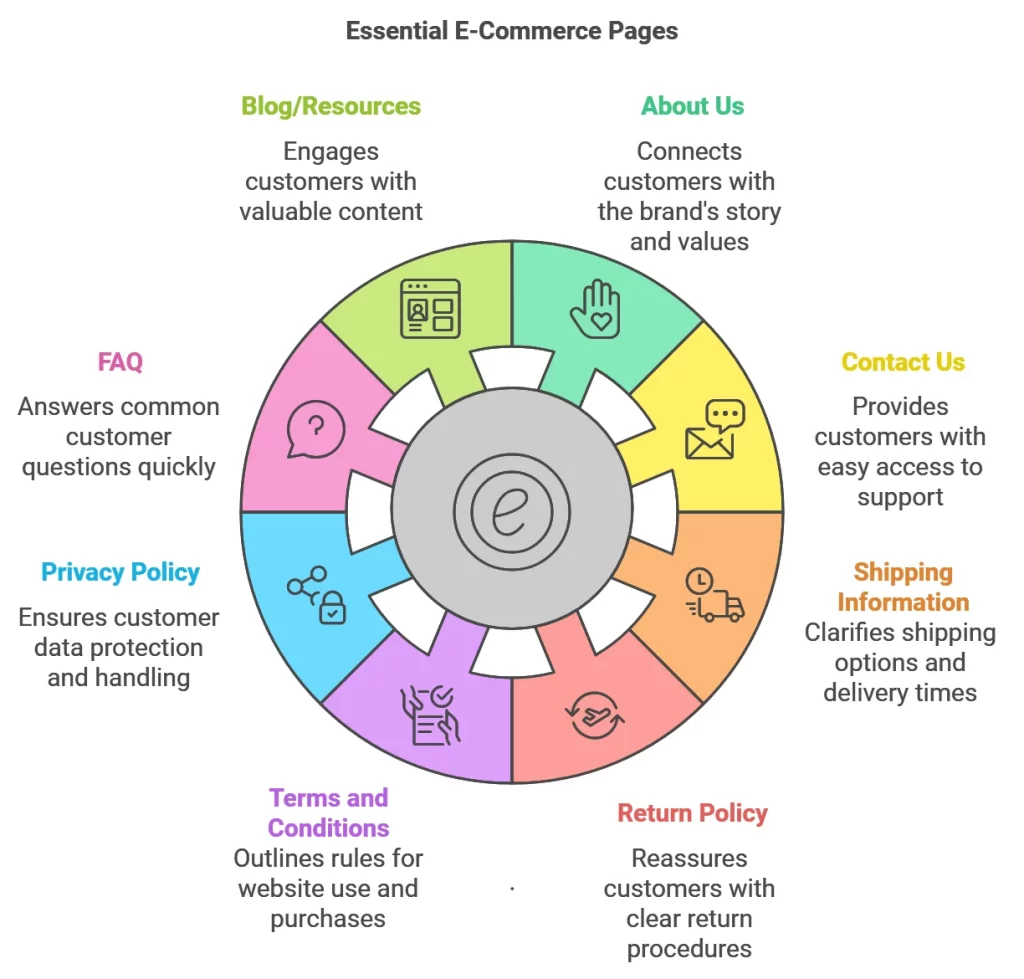
Here’s what you need to include:
About Us: Share your brand’s story, mission, and values. This helps customers connect with your business.
Contact Us: Provide a way for customers to reach you easily. Include your contact details and a form for enquiries.
Shipping Information: Explain your shipping options, rates, and delivery times.
Return Policy: Outline your return and exchange procedures to reassure customers.
Terms and Conditions: Clearly state the rules and conditions for using your website and purchasing products.
Privacy Policy: Explain how you protect customer information and handle data.
FAQ: Address common questions to help customers find answers quickly.
Blog/Resources: Add valuable content related to your products or industry to engage and inform your customers.
Step 8: Optimize Your Website for Search Engines
To attract more visitors to your e-commerce store, you need to make it easy for search engines like Google to find you.
Think of SEO (Search Engine Optimization) as putting up clear signs that guide people to your shop.
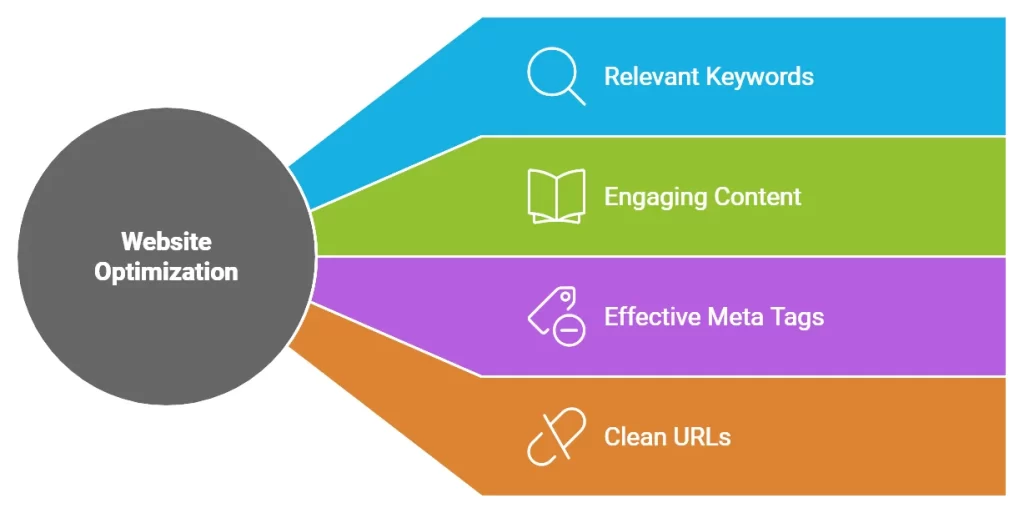
Here’s how to get started:
Use Relevant Keywords: Include keywords that potential customers might use when searching for your products in your product descriptions, meta tags, and URLs.
Optimize Content: Ensure your website content is engaging and relevant to your target audience. This includes clear, keyword-rich product descriptions and blog posts.
Improve Meta Tags: Write effective meta titles and descriptions that accurately reflect the content of your pages and include relevant keywords.
Clean URLs: Make sure your URLs are easy to read and include keywords related to your products or categories.
Step 9: Test Your Website and Prepare for Launch
Before you unveil your ecommerce website to the world, it’s crucial to thoroughly test everything to ensure a smooth launch.
This step is like making final checks before opening the doors to your store.
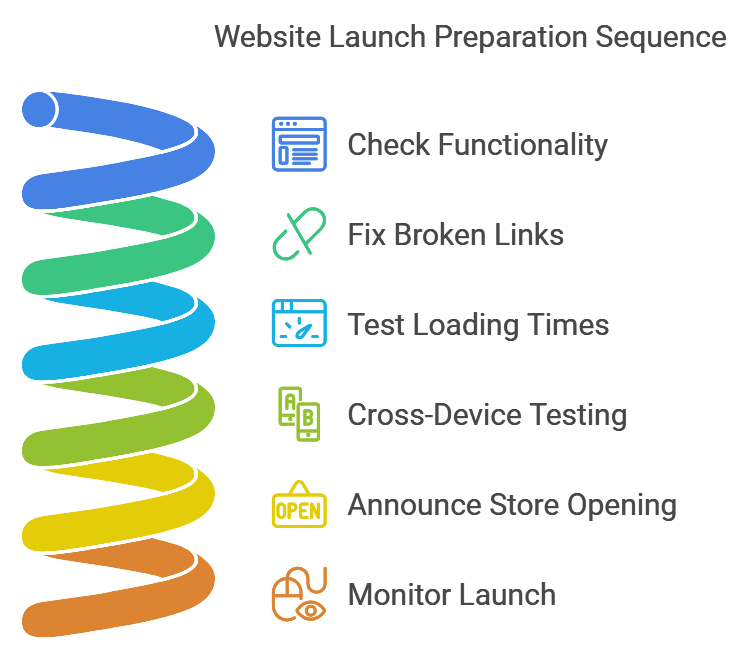
Here’s what to do:
Check Functionality: Test all website features, including product listings, payment processing, and shipping calculations, to ensure they work correctly.
Fix Broken Links: Make sure all links on your site are working and lead to the correct pages.
Test Loading Times: Verify that your website loads quickly to avoid frustrating your customers.
Cross-Device Testing: Test your website on various devices and browsers to ensure it looks and functions well everywhere.
Once you’ve tested everything and resolved any issues, announce your store’s opening through social media, email campaigns, and online ads.
Monitor the launch closely to address any unexpected problems quickly, ensuring a successful start.
Step 10: Promote Your Store and Keep It Growing
After launching your ecommerce website, it’s time to focus on attracting customers and keeping your store active.
This step is about making sure people know about your store and are excited to visit.
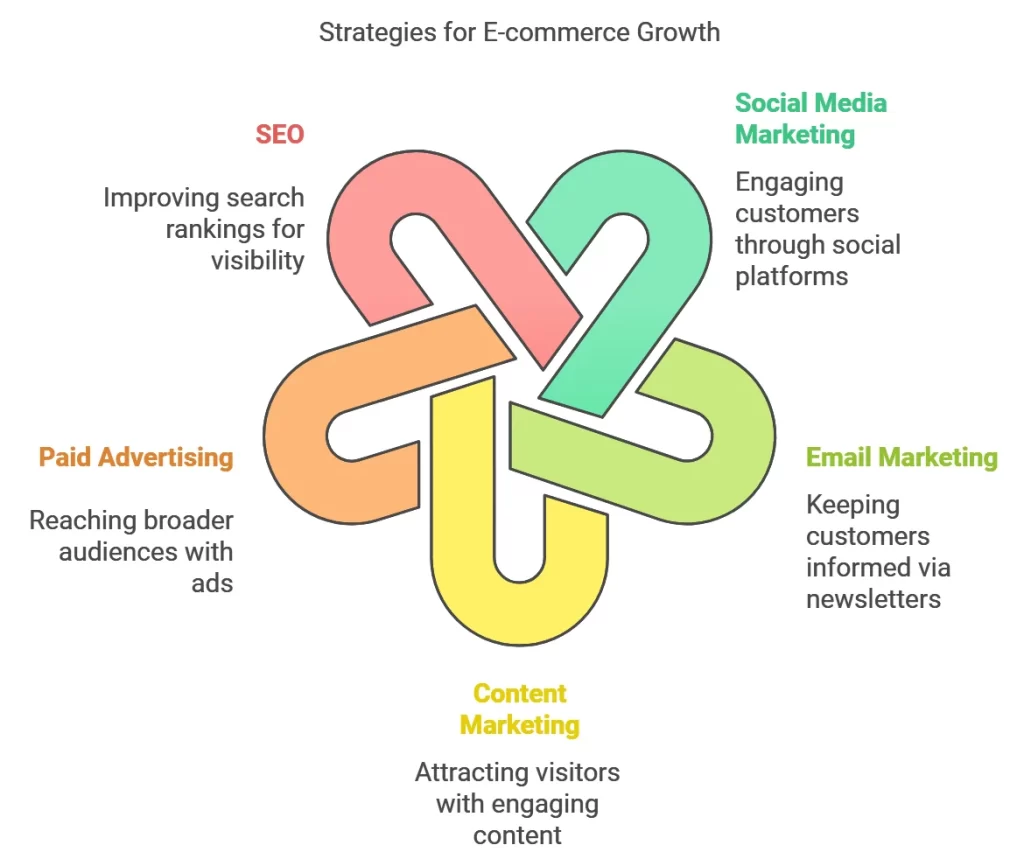
Here’s how to get started:
Social Media Marketing: Set up profiles on popular platforms like Facebook, Instagram, and Twitter. Share your products, promotions, and updates to engage with your audience.
Email Marketing: Build an email list by encouraging visitors to sign up. Send regular newsletters with updates, special offers, and valuable content to keep customers informed and interested.
Content Marketing: Create helpful and engaging content, such as blog posts, videos, or guides. This can attract visitors through search engines and build trust with your audience.
Paid Advertising: Use tools like Google Ads and social media ads to reach a broader audience. This can drive targeted traffic to your website and boost sales.
Search Engine Optimization (SEO): Continuously work on improving your SEO to enhance your search engine rankings. This helps more people find your store when searching for relevant products.
Step 11: Monitor Performance and Optimize
Once your ecommerce website is up and running, the next step is to keep a close eye on how it’s performing.
This means checking how well your website is doing and making any needed changes to improve it.
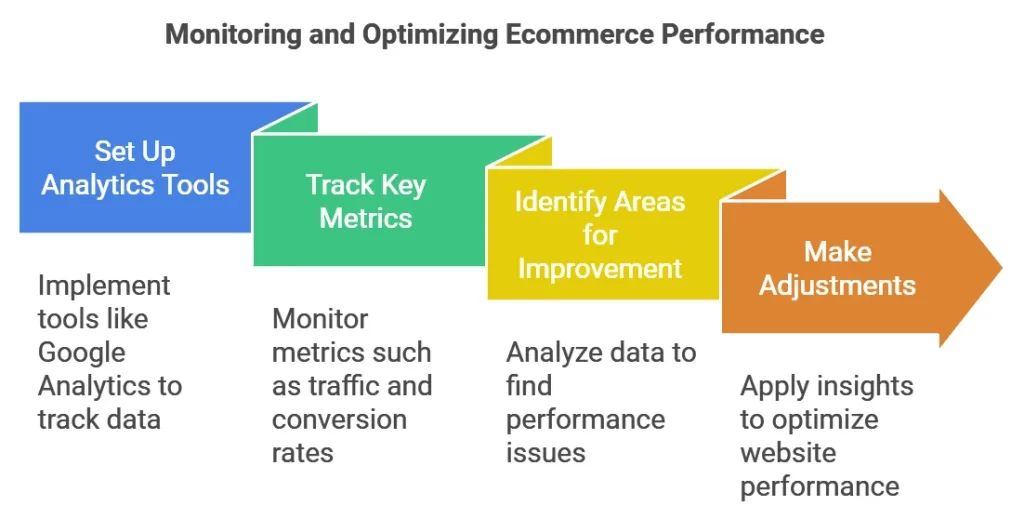
Here’s how to stay on top of things:
Use Analytics Tools: Set up tools like Google Analytics to track important data, such as how many visitors your website gets, what products are being bought, and how customers are behaving on your site.
Track Key Metrics: Pay attention to key metrics like website traffic, conversion rates (how many visitors make a purchase), and average order value. This helps you understand what’s working well and what might need improvement.
Identify Areas for Improvement: Look at the data to find areas where your website could perform better. For example, if visitors are leaving your site before completing a purchase, you might need to simplify the checkout process.
Make Adjustments: Use the insights you gain to make updates and optimizations. This might involve tweaking your website design, improving product descriptions, or adjusting your marketing strategies.
Essential Features of a Successful Ecommerce Website
Building an ecommerce website is more than just adding products and setting up a checkout page.
To truly succeed, your site needs to deliver a seamless, secure, and enjoyable shopping experience from start to finish.
Here are the key features that make it happen.
1. User-Friendly Interface and Navigation
First impressions matter—especially online.
A cluttered layout or confusing navigation can instantly turn visitors away.
Your ecommerce website should offer a clean, intuitive interface that guides users smoothly from browsing to buying.
Menus should be easy to locate, categories should make sense, and key actions—like adding to cart or checking out—should be obvious at a glance.
When users can find what they need effortlessly, they’re far more likely to convert.
2. Mobile Responsiveness and Cross-Device Compatibility
Today’s shoppers expect seamless experiences—whether they’re browsing on a laptop during lunch or checking out on their phones in line at a cafe.
That’s why mobile responsiveness isn’t optional; it’s essential.
Your website should adapt perfectly to any screen size, without losing speed or usability.
Responsive design not only improves user satisfaction but also supports your SEO efforts by keeping bounce rates low.
3. Secure Payment Gateways and Multiple Payment Options
Security is non-negotiable when it comes to online transactions.
Customers need to feel confident that their personal and financial information is protected.
Integrating trusted payment gateways like Stripe, PayPal, or Razorpay provides that peace of mind.
At the same time, offering a variety of payment options—such as credit cards, digital wallets, bank transfers, or Buy Now Pay Later services—makes checkout more convenient for everyone.
4. Product Catalog and Inventory Management
A well-structured product catalog does more than just display items—it helps customers find exactly what they’re looking for.
Clear descriptions, high-quality images, and real-time availability create a smooth shopping experience.
Behind the scenes, strong inventory management ensures you avoid common pitfalls like overselling or running out of stock.
When your catalog and inventory are synced, everything flows more efficiently—for both your business and your customers.
5. Shopping Cart and Checkout Process Optimization
Cart abandonment is one of the biggest challenges in ecommerce—but it’s also one of the most fixable.
An optimized checkout process should be fast, transparent, and hassle-free.
Features like guest checkout, progress indicators, auto-fill options, and upfront shipping information all contribute to a smoother transaction.
The goal?
Make the buying process so seamless that completing a purchase feels like second nature.
6. Customer Accounts and Wishlist Features
Offering customers the option to create an account adds long-term value.
It allows them to view order history, track shipments, and save products for later.
Wishlist functionality is especially helpful for shoppers who are still deciding or waiting for a promotion.
These features not only improve user experience but also give your business valuable insights into shopping behavior—allowing for more targeted marketing down the line.
7. Search and Filter Functionality
Not every visitor comes to browse.
Many arrive with a specific item in mind—and a powerful search tool helps them find it instantly.
Features like auto-suggestions, typo tolerance, and voice search can elevate the experience.
Add to that smart filtering by price, size, brand, color, or rating, and users can zero in on their ideal product without frustration.
It’s all about reducing friction and getting them to the “Buy Now” button faster.
8. Reviews and Ratings Integration
Online reviews are the modern word-of-mouth—and they carry significant influence.
Displaying customer reviews and product ratings directly on your site builds trust and credibility.
It gives new shoppers the confidence to buy and helps answer questions that product descriptions alone might not cover.
Encouraging reviews (and responding to them) also shows that your brand values feedback and transparency.
9. Multi-Language and Multi-Currency Support
If your ecommerce business caters to a global audience, then localized experiences are a must.
Supporting multiple languages and currencies not only makes shopping more convenient but also signals respect for cultural and regional differences.
Auto-detecting a visitor’s location and adjusting content and pricing accordingly can go a long way in building trust—and increasing international sales.
Security Considerations for Ecommerce Websites
Let’s face it—online shoppers are more cautious than ever.
When people visit your ecommerce store, they’re trusting you with sensitive information like credit card numbers, addresses, and contact details.
That’s a big responsibility.
If your site doesn’t feel secure, chances are they’ll walk away before ever clicking “Buy Now.”
Here are some critical security practices that every ecommerce website should have in place:
1. SSL Certificates Are a Must
If your site doesn’t start with “https,” you’ve already lost your visitor’s trust.
SSL (Secure Sockets Layer) encrypts the data that moves between your website and your customer’s browser, keeping it safe from snooping eyes.
Plus, it’s a key factor for search engines and essential for payment gateway integration.
2. Use Trusted Payment Gateways
Don’t try to handle sensitive payment data on your own.
Instead, rely on trusted gateways like PayPal, Stripe, or Razorpay.
These providers are PCI-DSS compliant, meaning they follow strict security standards to protect cardholder data—giving both you and your customers peace of mind.
3. Encrypt Stored Data
Even with secure transmissions, the information stored in your database needs protection too.
Passwords, addresses, and payment details should all be encrypted to prevent them from being exposed in case of a breach.
4. Stay Updated—Always
Outdated plugins, themes, or ecommerce platforms are low-hanging fruit for hackers.
Make it a habit to regularly update everything—from your CMS and extensions to your server software.
A simple update can close the door to many potential threats.
5. Invest in Firewall & Malware Protection
A web application firewall (WAF) acts like a security guard for your website, blocking malicious traffic before it gets in.
Combine that with malware detection tools that scan for suspicious activity, and you’ve got a solid first line of defense.
6. Strong Login Security
Start with the basics—require strong, unique passwords from both customers and administrators.
Then go a step further by enabling two-factor authentication (2FA), limiting login attempts, and changing default admin URLs to something less predictable.
7. Protect Your Admin Panel
Your admin dashboard is like the control room of your online store.
Protect it by restricting access to only authorized IPs, using secure logins, and regularly reviewing user roles and permissions.
The fewer people who have access, the safer your site will be.
8. Backup Everything—Regularly
No matter how secure your site is, things can still go wrong.
That’s why regular backups are essential.
A full-site backup ensures that if your website is ever compromised, you can restore it quickly without losing valuable data or sales.
9. Follow Privacy Laws Like GDPR
If you’re serving customers in the EU or other regulated regions, compliance with data privacy laws like GDPR is non-negotiable.
Be transparent about how you collect and use data, and make sure users have control over their personal information.
Why Ecommerce Website Development is Important for Your Business Today?
More and more customers are choosing to shop online instead of visiting physical stores.
By 2026, online shopping sales are set to hit an incredible $7.5 trillion!
This shows just how important it is for businesses to have an e-commerce website today.
Companies are making more money online than they ever did with their physical stores because ecommerce lets them sell directly to customers, boosting their revenue.
Plus, an online store is always open, letting you reach customers anywhere, anytime.
Look at brands like boAt in India and Beardbrand in the US – they’ve skyrocketed to success by going online.
If you’re still hesitating about moving beyond your physical store, here’s why investing in ecommerce website development is a no-brainer.
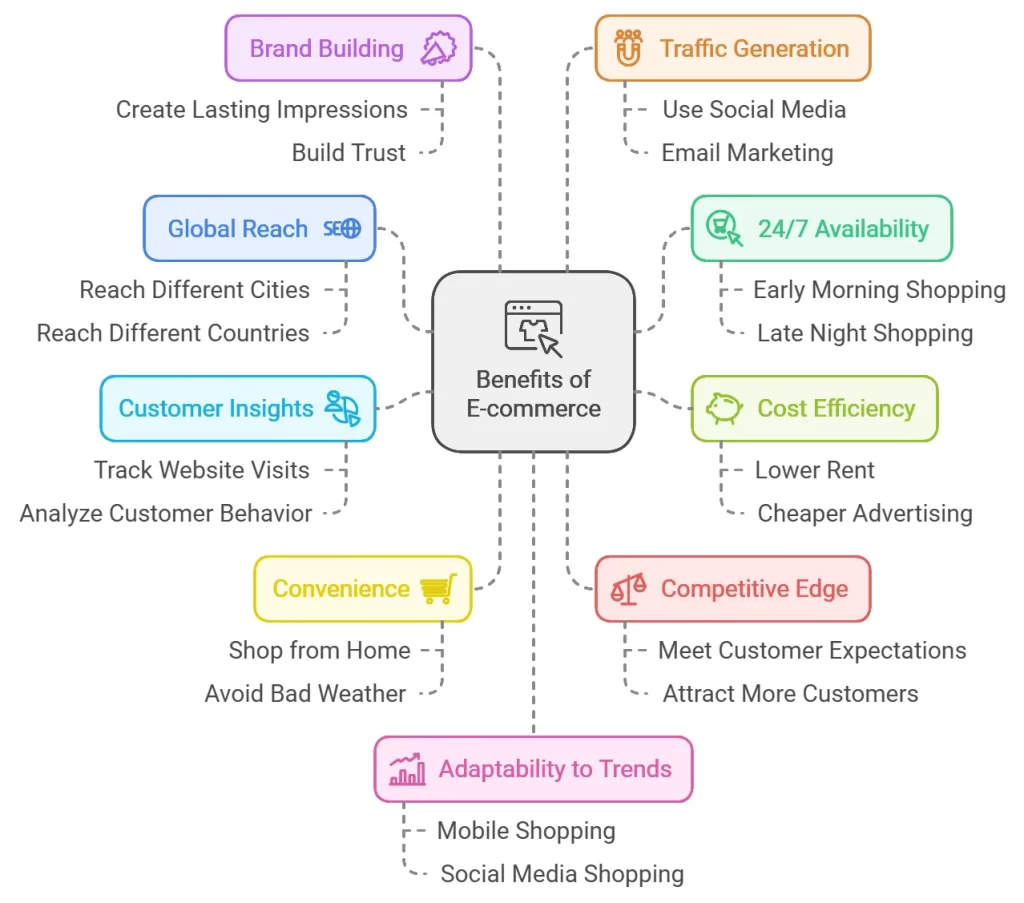
1. Reach More Customers, Anywhere
With an e-commerce website, your business isn’t limited to the people who walk by your store.
You can reach customers in different cities, states, or even countries!
It’s like having a shop that anyone in the world can visit.
If you want to grow your business, going online is a must.
2. Open 24/7, No Closing Time
One of the best things about an ecommerce website is that it’s always open.
Customers can shop anytime – whether it’s early in the morning or late at night.
This is especially great for people who work odd hours or live in different time zones.
Your store never misses a sale because it’s always ready for business.
3. Save Money, Make More
Starting and running an online store costs a lot less than opening a physical one.
You don’t have to worry about paying rent or utility bills, and maintenance is much simpler.
Plus, advertising online is usually cheaper and more effective than traditional ads.
This means you can save money while reaching more people.
4. Get to Know Your Customers
When you run a physical store, it’s hard to know why a customer left without buying anything.
But with an e-commerce website, you can see exactly what’s working and what’s not.
You can track things like how many people visit your site, what they’re looking at, and why they might leave without making a purchase.
This information helps you understand your customers better and improve your business.
5. Make Shopping Easy and Fun
People love convenience.
An ecommerce website lets your customers shop from the comfort of their own homes.
No need to deal with bad weather, find parking, or stand in long lines.
This makes shopping with you easy and stress-free, which keeps customers coming back.
6. Stay Ahead of the Competition
Today, customers expect businesses to have an online presence.
If your competitors have websites and you don’t, you could be missing out on a lot of sales.
By having an e-commerce website, you can stay competitive and attract more customers.
7. Build a Strong Brand
If your physical store already has a good reputation, moving online can make your brand even stronger.
An ecommerce website helps you create a lasting impression on your customers.
Over time, this can turn your business into a well-known and trusted brand.
8. Drive Traffic to Your Store Easily
With a physical store, you rely on foot traffic and local ads to attract customers.
But with an ecommerce website, you can use social media or other digital marketing strategies like pay-per-click ads, and email marketing to bring customers to your store.
It’s much easier and faster for customers to check out your products online, leading to more sales.
9. Keep Up with Changing Shopping Habits
Shopping habits are always changing.
With more people shopping on their phones and through social media, an ecommerce website ensures your business stays relevant.
By adapting to these changes, you can continue to meet your customers’ needs and keep your business growing.
Top 5 Challenges of Ecommerce Web Development
The ecommerce industry offers several benefits to businesses.
But It also comes with certain challenges, which can be overcome with the right planning.
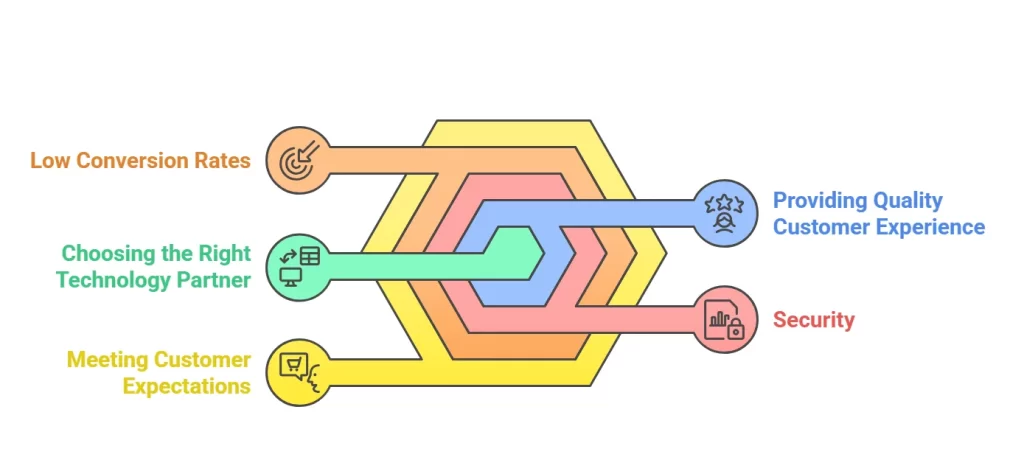
1. Meeting customer expectations
Customer expectations from online shopping experiences are evolving continuously.
Due to the high competition in the ecommerce industry, meeting the customer expectations is vital for sales.
From browsing to purchase, shipping and post-delivery services, customers look for ease and convenience.
Solution
Create a strong strategy by doing competitor analysis and market study.
Ensure your ecommerce platform is mobile-friendly as mobile shopping is increasing in volume.
Use data analytics to understand the shortcomings of your ecommerce platform and improve the user experience.
Provide timely customer service to solve customer queries quickly.
2. Low conversion rates
Getting a user from browsing to buying is one of the biggest challenges of ecommerce.
With similar options available elsewhere, visitors convert based on factors such as shopping experience, deals and convenience.
Solution
Work with an established ecommerce web development company to ensure that your platform is user-friendly
Provide discounts and deals to prompt users to checkout the products
Make checkout process easy and fast by asking for minimal information
3. Security
Protecting the customer data is the responsibility of the ecommerce business platform.
As issues like data breaching and identity theft are increasing, ensuring cyber security is crucial.
Solution
Ensure your website is protected by security plugins
Use credible and established payment gateways for the financial transactions
Implement multi factor authentication measures and encrypt all sensitive information
4. Providing quality customer experience (CX)
49% of buyers make impulse purchases if the customer experience is personalized.
CX is emerging as a differentiator in the ecommerce space.
For an ecommerce platform to be successful, the customer experience has to be top-notch.
Solution
Hire professional UI UX design services to improve the user experience
Use data analytics to understand user behaviour and provide personalized recommendations
5. Choosing the right technology partner
Several technologies like Magento, Drupal, Shopify and BigCommerce are available in the market for ecommerce website development.
Depending on your business needs, you have to choose the right technology.
Otherwise it may limit your growth and success.
Solution
Research on the different technology stacks available. Talk to ecommerce business owners and understand their technology partner and its performance
Partner with an established ecommerce web development agency and let them guide you on the best technology stack
Best Practices for Ecommerce Website Development
Each decision taken during ecommerce website development can affect the sales of a website.
So here are a few best practices that you can follow while developing an e-commerce website.
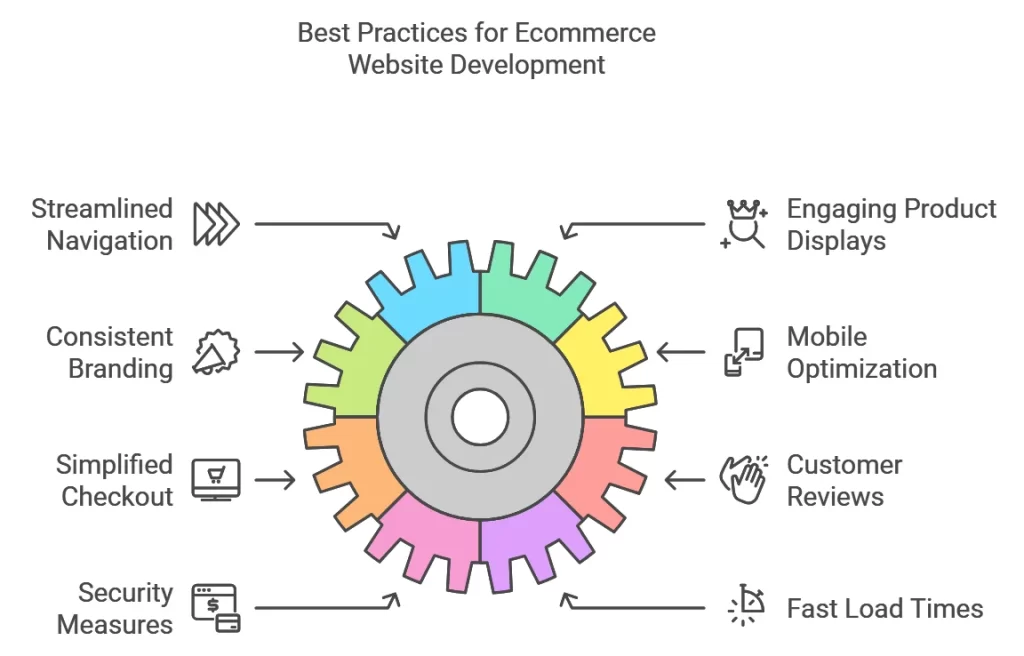
1. Streamlined Navigation and Optimised User Experience
Your e-commerce website should resemble a well-organized store, with clear labels and distinct product categories.
Incorporate hover-based drop-down menus and a prominent search bar with an auto-complete feature to help consumers find what they need easily and keep them engaged.
2. Engaging Product Displays with High-Resolution Images
Zara, a well-known brand, effectively uses stunning images and styling tips to enhance its product displays.
Ecommerce websites can similarly boost conversion rates by featuring high-resolution images, showcasing products from multiple angles, and offering a zoom feature.
3. Consistent and Impactful Branding
For an e-commerce website to be successful, it needs to follow consistent branding.
From color schemes to logos and even fonts, business owners should make sure that their identity is reflected in all aspects of the website.
4. Optimised Design for Mobile Devices
With the mobile e-commerce industry valued at $2.2 trillion and nearly 79% of customers now ordering via phones, your website must be as flexible as a shop that fits right into any customer’s pocket.
Features like easy-to-navigate menus and touch-friendly buttons can help in creating a user-friendly website.
5. Efficient and Simple Checkout Process
After shopping, customers expect a straightforward checkout process.
E-commerce websites should simplify the checkout process by reducing the number of form fields and offering a guest checkout option.
Providing multiple payment methods also ensures customers can complete their purchases without unnecessary steps or account creation.
6. Prominent Customer Feedback and Reviews
Customer reviews serve as digital endorsements for your store.
Display them prominently to build trust and provide social proof.
Encourage reviews by asking after purchases or offering incentives, as authentic feedback enhances credibility and attracts new customers.
7. Strong Security Measures and Trust Indicators
E-commerce websites should be like a secure vault with robust security measures like SSL encryption to keep data and transactions safe.
Security certificates, payment method icons, and privacy policies make the customers feel safe and secure.
8. Optimisation for Fast Page Load Times
A slow-loading ecommerce website is like a store with long checkout lines that turn customers away.
To keep your site fast and engaging, optimize images, streamline your code, and use content delivery networks (CDNs).
Avoid cluttering your pages with too many elements or large files that could drag down performance.
Speed is especially important for mobile users, who expect a quick and seamless browsing experience.
By focusing on fast load times, you keep visitors engaged, lower bounce rates, and provide a smooth shopping journey from start to finish.
How Much Does it Cost to Build an Ecommerce Website?
Every ecommerce website will be different depending on the products they sell and their mode of operation.
Hence, it’s difficult to give an exact estimate of the cost of building an ecommerce website.
Factors like the platform, complexity, integrations and design can affect the website cost.
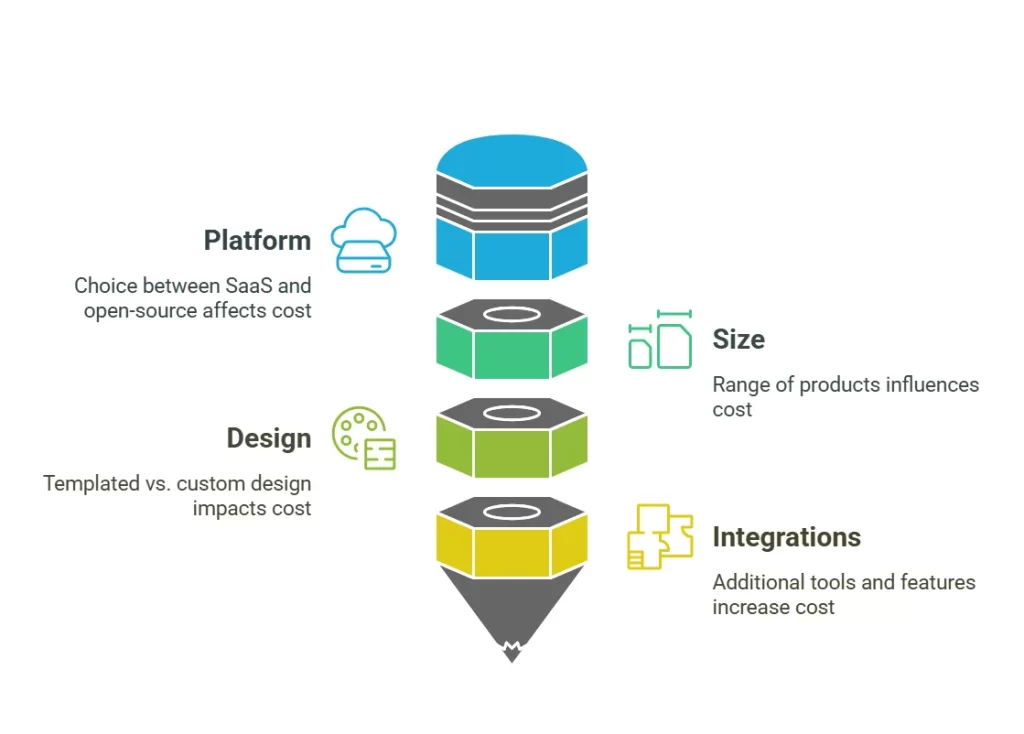
Platform: SaaS platforms like Shopify and BigCommerce operate on a subscription basis and have a monthly/annual fee. Hosting and some other features are included in the monthly fee. Magento, WooCommerce etc. are open source platforms that require more setup and offer better flexibility. If you are creating a website from scratch, it will offer more personalization but has higher cost.
Size: If your ecommerce platform has a wide range of products, and requires advanced search and filter options, it will increase the cost.
Design: You can either go with a templated design or have your own design for your ecommerce platform. While templates are more affordable, they limit the user experience and the design features.
Integrations: If you require integrations like CRM integrations, social media tools or email marketing tools, it will increase the cost.
5 Essential Factors to Consider When Choosing Your E-commerce Web Developer
Choosing the right web developer is crucial for building an e-commerce website that looks great and drives sales.
A well-developed online store enhances user experience, boosts conversions, and supports business growth.
Here are some factors to consider when hiring an E-commerce web developer:
Proven Expertise in E-commerce Development: Look for developers with hands-on experience in e-commerce website design and online store development. Review their portfolio to ensure they have built fast, secure, and optimized websites that drive sales.
In-depth knowledge of E-commerce Platforms: Whether it’s Shopify, Magento, or WooCommerce, your developer should have strong expertise in multiple e-commerce platforms. They should also guide you in selecting the platform that best aligns with your business model and goals.
Focus on Customization and Scalability: Your website should be as unique as your brand. Choose a developer who can create custom features and ensure the site is scalable, allowing it to grow seamlessly alongside your business.
SEO and Mobile-First Approach: A visually appealing site isn’t enough. Ensure your developer integrates SEO best practices and prioritizes mobile optimization, as a significant portion of online shopping happens on mobile devices.
Reliable Support and Post-Launch Maintenance: A great e-commerce solution requires ongoing support. Your developer should offer regular updates, security checks, and technical assistance to ensure your website continues to run smoothly.
Conclusion
Every business today recognizes the value of going online.
Even traditional giants like IKEA and Nike have tapped into the power of e-commerce.
IKEA, for instance, has boosted its success by offering 3D room planning tools online, making it easier for customers to visualize their spaces.
Nike has also leveraged e-commerce by providing exclusive online products.
By partnering with a good ecommerce website development company, you can ensure that your online store is not only built to scale but also stays ahead of the latest trends.
This approach can help you attract new customers, boost sales, and secure long-term success in the digital marketplace.
Is starting an online store your dream? Partner with GMI, one of the the leading digital marketing companies in Dubai. No matter what kind of business you want to launch online, we can help you set it up in the best possible way. We offer web design, web development, eCommerce design and development, and SEO services for businesses in the UAE and beyond. Contact us now!
Frequently Asked Questions
How long does it take to develop an ecommerce website?
The development time for an e-commerce website varies based on its size and complexity. A simple store can be ready in a few weeks, while more complex ones may take several months.
What are the essential features of an ecommerce website?
Essential features include a product catalog, shopping cart, secure checkout, payment gateway integration, search function, customer accounts, order tracking, and mobile-friendly design.
How can I improve the conversion rate of my ecommerce website?
To boost conversions, focus on:
Clear product pages: Ensure your product pages are well-organized, informative, and visually appealing.
Strong calls to action: Use persuasive language and clear buttons to encourage customers to take the desired action (e.g., “Add to Cart,” “Buy Now”).
A quick and secure checkout: Streamline the checkout process and prioritize security to minimize cart abandonment.
Excellent customer service: Offer responsive and helpful support to address customer questions and concerns promptly.
Attractive pricing: Competitive pricing can be a major factor in influencing purchasing decisions.
Timely and accurate order fulfillment: Ensure orders are processed and shipped promptly, and provide accurate tracking information.
What is the role of SEO in ecommerce website development?
SEO helps your website rank higher in search engine results. By optimizing for relevant keywords, you can attract organic traffic and increase sales.

GMI’s Research Team is a panel of knowledgeable experts from various fields such as digital marketing, social media, and web development, all united by a common goal—to educate. We enjoy exploring everything from the latest industry trends and emerging technologies to people and demographics, both in the UAE and beyond. Through our blog posts, we share valuable insights that help businesses and marketers stay informed and prepared for the challenges and opportunities that lie ahead.









